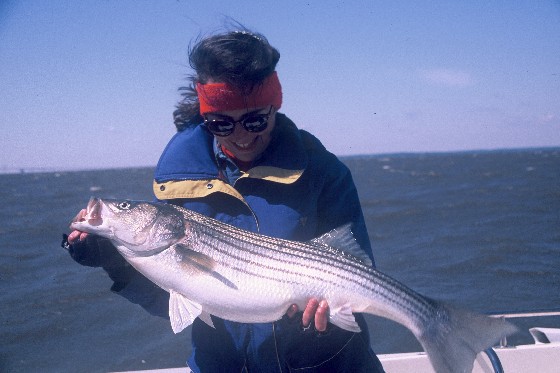Striped Bass Fishing at Night
The best time for summer striped bass is after dark. It is up to you to find them.
August 20, 2010
Sometimes, at night, you can hear them. Slurping, gurgling, or slapping their tails against the water. Then the adrenaline kicks in, because a hookup is bound to come soon. On those occasions it’s easy to understand why the dedicated angler foregoes sleep to chase striped bass. On any given summer day, the best chance to catch a striper happens after the sun goes down.
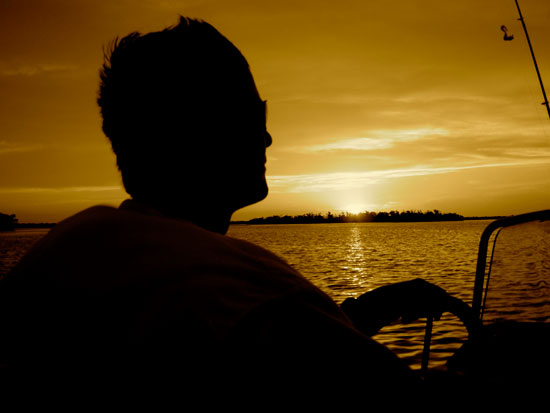
Successful night fishing means trusting your senses, along with an assist from modern technology.
In the blazing heat of day (and this June and July were two of the warmest in recorded history), striped bass head to deeper, cooler water to maintain their metabolism and shield their sensitive eyes from the bright sunlight. They start to perk up around dusk and, depending on tides and location, can feed all the way to sunrise. Keep on top of them by trusting your senses, and with an assist from modern technology.
Sight
Your eyes won’t help you too much at night. According to the American Optometric Association, the eye uses its cones for fine detail and depth perception in the light, but at night relies on rods to pick up dim detail, which is called scotopic vision. According to the AOA, “Scotopic vision is of poorer quality; it is limited by reduced resolution (20/200 or less) and provides the ability to discriminate only between shades of black and white.” Exposed to bright lights at night, your eyes will need 35-40 minutes to adjust to dark conditions. That’s why you should change out the light in your livewell and on your console to red lights, which won’t ruin your night vision.
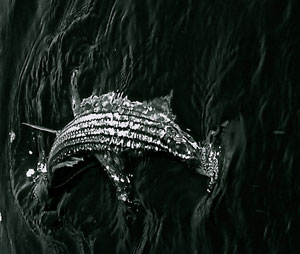
The best way to use your eyes for night fishing is to scout during the day. “A lot is definitely looking for bait during the daytime,” said Jason Puris of thefin.com who fishes for striped bass almost exclusively at night. “If there’s no bait around, there won’t be fish either.” Since bait and fish movements are tide-dependent, check out spots during the certain stages of the tide in daylight for an idea of how they’ll fish at night.
Also, pre-scout rips and structure that you can easily find at night. Bridges and docks with lights that shine down on the water are great places to look for bass, who ambush passing bait from the shadow lines. Plug these spots into your GPS or Chartplotter for help getting back when the lights go down.
Sound
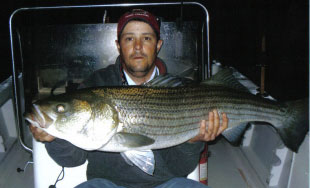
A night catch. Photo courtesy of Capt. Mike Warecke, www.ctfishsaltwater.com
The tail slapping and bait crashing are awesome audial cues, but not always discernible, especially over ambient engine noise. As the fish move into the shallows to feed at night around rocks and structure, best to anchor before killing the engine for a listen, or you might hear the sound of crunching fiberglass. If you don’t pick up feeding fish, listen for rips and crashing waves that could lead you to bass hiding places.
Smell
Walking past the seafood section of the supermarket should clue you in to fish smell. On the water, you can use that to your advantage. “Sometimes, if there’s a light breeze,” said Puris, “I’ll get hit with that melon-type smell of striped bass, and I’ll stop.” An experience night angler can tell the difference between bass and bluefish scent, and work from there to locate the school, which must be sizable and close to the surface to leave that lingering odor.
The other two senses won’t help you too much on a night trip, unless you file being able to tie knots, judge casting distance, and work the cockpit of the boat without lights under “touch.” And taste as using some sort of legal stimulant to help you stay awake and alert.
A Little Help
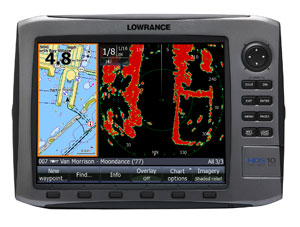 If you’re willing to pay for it, there are some cool electronics that can help boating at night. Check out broadband radar, like the Lowrance B24 Broadband Radar unit ($1,699). Combine the BR24 with a Lowrance HDS screen to get intricate close range detail with almost real time updating and no “main bang” blind spot. I’ve demo-ed the system; it’s easy to use and you can pick up markers, dock pilings, mooring buoys as well as other vessels, at extremely close range. We even picked up a seagull floating nearby.
If you’re willing to pay for it, there are some cool electronics that can help boating at night. Check out broadband radar, like the Lowrance B24 Broadband Radar unit ($1,699). Combine the BR24 with a Lowrance HDS screen to get intricate close range detail with almost real time updating and no “main bang” blind spot. I’ve demo-ed the system; it’s easy to use and you can pick up markers, dock pilings, mooring buoys as well as other vessels, at extremely close range. We even picked up a seagull floating nearby.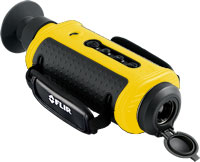
A FLIR First Mate handheld camera ($2,600) helps you see in the dark. The waterproof unit relies on thermal imaging and doesn’t need ambient light to produce an image. It can help you locate places to fish and after a long night of catching stripers, can help you get home.











